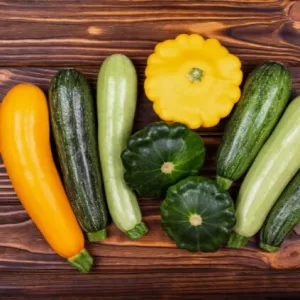Zucchini: The Green Jewel of Cuisine and Nutrition
Versatility and Flavor in the Form of a Vegetable
Zucchini, often hailed as the green gem of the vegetable world, is celebrated for its versatility in the kitchen and its impressive nutritional profile.
This article delves deep into the fascinating history of zucchini, explores its diverse varieties, and highlights its unique culinary and health benefits. As an ingredient that is both delicious and healthy, zucchini has earned its place as a staple in diets and kitchens globally.
The Rich History of Zucchini
Zucchini, scientifically known as Cucurbita pepo, belongs to the extensive cucurbit family, which also includes pumpkins, cucumbers, and melons. Its origins can be traced back to the Americas, where it was domesticated over 7,000 years ago.
However, zucchini’s journey to becoming a worldwide culinary staple began with the exploration of the New World. By the 19th century in Italy, zucchini had evolved into the form we recognize today, gaining popularity and the name “zucchino,” meaning small squash, due to its size and shape.

Exploring the Varieties of Zucchini
The world of zucchini is as diverse as it is flavorful, with each variety offering unique characteristics suited for different culinary applications. Here, we examine some of the most popular types:
Italian Zucchini
The most commonly found variety in markets, Italian zucchini is known for its dark green skin and rich nutrient content, including B vitamins and antioxidants. Its robust texture makes it ideal for stuffing, grilling, and roasting, allowing the flavors to develop fully.
Yellow Zucchini
Distinguished by its vibrant yellow color, this variety resembles its green counterpart in terms of nutritional value. It adds a splash of color to salads and is perfect for dishes requiring visual appeal, enhancing both the aesthetics and flavor of a meal.
Round Zucchini
True to its name, this zucchini is round and plump, making it an excellent choice for stuffing. It retains its shape well during cooking and offers a good amount of dietary fiber, making it both a filling and nutritious option.
Romanesco Zucchini
Notable for its distinct ridges and slightly sweeter taste, Romanesco zucchini is rich in vitamin A. Its firmer texture and more defined flavor make it suitable for dishes where these qualities are needed.
Lebanese Zucchini
Known as Middle Eastern zucchini, this variety stands out for its short, wide shape and smooth, light green skin. With a tender texture and mild, slightly sweet flavor, it cooks quickly and is versatile enough for sautéing, stuffing, or using raw in salads. Nutritionally, it provides vitamin C and potassium, while being low in calories.
Brazilian Girl Zucchini
A variety popular in Brazil, the Brazilian Girl zucchini is characterized by its dark green skin with lighter stripes. It maintains a uniform size and shape, with firm flesh and a mild flavor, making it perfect for a range of culinary uses, from sautéed dishes to pickles and baked goods.
Paulista Zucchini
Essentially an early-harvest Brazilian Girl zucchini, the Paulista variety is drier with lighter stripes. Its firm texture and mild flavor make it ideal for stews, baked dishes, and even doughs for pies and cakes. Like other zucchinis, it is rich in antioxidants and vitamins, supporting a healthy diet with its low calorie content.
Organic Zucchini
Cultivated without pesticides, organic zucchini often boasts a richer flavor and slightly higher levels of vitamins and minerals due to sustainable farming practices. This variety appeals to those seeking both health benefits and environmental responsibility.
Nutritional Powerhouse
Zucchini is not only versatile in the kitchen; it is also a nutritional powerhouse. It is rich in essential nutrients, offering a generous supply of vitamin C, potassium, and B vitamins. Additionally, zucchini is a low-calorie vegetable, making it an excellent choice for those looking to maintain or lose weight. Its antioxidant content, including lutein and zeaxanthin, supports eye health, while its dietary fiber aids digestion and promotes a feeling of fullness.
Culinary Uses and Adaptability
One of zucchini’s most appealing features is its adaptability in the kitchen. It can be incorporated into a wide array of dishes, from savory to sweet, providing endless culinary possibilities. Zucchini can be grilled, roasted, sautéed, or used raw in salads. Its mild flavor allows it to blend seamlessly into both main dishes and unexpected desserts. Whether being spiralized into noodles, baked into bread, or stuffed with a variety of fillings, zucchini proves itself to be a chameleon in culinary applications.
Conclusion
Zucchini, with its diverse varieties and rich nutritional benefits, stands as a true jewel in the culinary world. Its ability to adapt to numerous cooking styles and its nutritional value make it an indispensable ingredient in healthy eating. As we explore the range of zucchini options, from the common Italian to the exotic Lebanese, we celebrate a vegetable that is both a culinary star and a health ally. Embrace the versatility and goodness of zucchini, and let it transform your meals into vibrant, nutritious experiences.